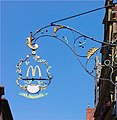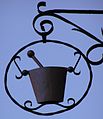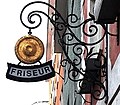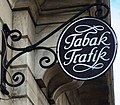Nasal shield
The nose shield , also known as a cantilever, is a traditional form of advertising . It is an advertising sign that is anchored on the wall of a restaurant or shop and protrudes from the house into the street at right angles, like a nose out of the face. It is particularly suitable for drawing passers-by to the attention of a shop and is designed so that its license plate can be clearly seen from both sides.
Today, information signs such as authority signs or safety signs that are mounted at right angles on a wall are also known as nose signs.
history
Since the Middle Ages, the inns have been showing passers-by with a wreath of leaves hanging over the door.
In German-speaking countries, nose shields were often made of iron by blacksmiths with considerable craftsmanship . Attention is drawn to the advertised craft or the offer from a merchant not with text, but with symbols - for example guild symbols .
Restaurants with traditional names such as “Zum Hirsch”, “Zum Bären” or “Zur Post” also draw attention to themselves with a graphic representation of their name.
Even in the time when enamel signs were becoming modern, nose signs were still used as advertising media.
technology
Depending on the center of gravity and weight, nose shields exert a high torque on the attachment. If this moment can be supported on a high fastening base, the tensile forces on the upper fastening screws are lower. The wind forces are also considerable in a storm and the base of the fixture is often narrow. A board that is hung from the boom by two eyelets can swing out to the side in the wind, which reduces wind power. Even a tall car that hits it does less damage.
The following old type of assembly can also be seen in Graz : On the wall of the house, two irons are walled in, each of which has only a small ring or a sling - also open at the top - protruding. Two bent round bars of the shield hook vertically from above into their openings, forming a hinge on which the nose shield can be folded sideways towards the wall if necessary - for example, when a large car is being driven past or scaffolding is being put on. In order to spread the boom out at a right angle, a horizontal strut at an angle of about 45 ° to a third ring on the side of the house wall - a very windproof construction.
Nose shields today
For decades, home and business owners let traditional nose shields rust and dismantle. Since ironworks have met with increased interest, there has been a return of the nose shields. Old nose shields are restored and some new ones are commissioned, albeit more from restaurants and hotels, especially in old town locations or in historic village centers than from shops and craftsmen. This renaissance is also facilitated by the fact that local statutes for the protection of historic town centers often permit traditional nose shields, but largely prohibit or restrict other outdoor advertising .
Gallery of nose shields
- Gastronomy, pub signs
Nose shield at the Alte Post, Rheinhausen
Restaurant Drei Bünde in Chur
Brauhaus zum Ritter in Schwetzingen
Hotel Adler Post in Schwetzingen
Castle restaurant at Lichtenberg Castle (Pfalz)
To the old post office in Kusel
"Lower Sun" in Constance
Weinhaus Knöringer in Memmingen
Traditionally shaped nose shield with support struts: “Zum Hirsch” inn, Mingolsheim
Nose shield of a hotel "Adler", with post horn (formerly post office) in Schwetzingen
Simple sign at the Gasthof zur Kanne-Post in Knittlingen
McDonald’s sign in Rothenburg ob der Tauber
- Guilds, shops
Nose shield of a travel agency in Rottweil (2017)
Individual evidence
- ↑ Time travel back to the Middle Ages on geo.de.
literature
- Eckart Hannmann: On the subject of advertising systems. Three examples from Rottenburg a. N., Tübingen district. In: Denkmalpflege in Baden-Württemberg , 3rd year 1974, volume 4, pp. 31–34 ( PDF ) [not evaluated]
- Leonhard Walter: Nice old pub signs. A sign of good hospitality . 2nd Edition. Bruckmann, Munich 1977, ISBN 3-7654-1494-8




























